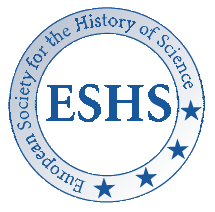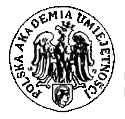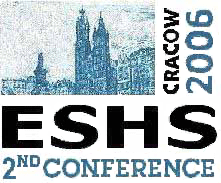Last modification: 25 September 2008
Online Book of Abstracts - A Thematic List:
SESSIONS / SYMPOSIA
Edited by Michal Kokowski
http://www.cyfronet.pl/~n1kokows/home.html
n1kokows@cyf-kr.edu.pl
Symposium R-10.
FROM MARIA SKLODOWSKA-CURIE TO THE 21ST CENTURY:
WORKING ON WOMEN AND SCIENCE IN HISTORY OF SCIENCE
ORGANIZERS OF THE SYMPOSIUM:
Annette B. VOGT (Berlin, Germany)
vogt@mpiwg-berlin.mpg.de
Maria RENTETZI (Athens, Greece)
mrentetz@vt.edu
CHAIRPERSONS OF SESSIONS OF THE SYMPOSIUM:
Ida H. STAMHUIS (Amsterdam, The Netherlands)
stamhuis@few.vu.nl
Sona STRBANOVA (Prague, The Czech Republic)
sstrban@vol.cz
Éva Katalin VÁMOS (Budapest, Hungary)
vamos.eva@chello.hu; evamos@nadir.hmst.hu
Annette B. VOGT (Berlin, Germany)
vogt@mpiwg-berlin.mpg.de
R-10.
Our Marie Curie's - Women physicists in Vienna
Brigitte BISCHOF (Vienna, Austria)
brigitte.bischof@univie.ac.at
Not only Lise Meitner was called "our Marie Curie" by Albert Einstein, but a great number of women too who were graduated in physics at the University of Vienna in the first half of the 20th Century. Following previous investigations on women at the Vienna Institute for Radium Research this paper will present further research on women's access to study and employment in physics in Vienna, combining both analytical evidence and personal testimonies. There can be found a remarkable boom in physics at the University of Vienna in the thirties of the 20th Century, and it was in these years, that there were many female students (up to 35%). To find an explanation for this high amount (in proportion and in number) and especially the decline afterwards, is one of the purpose of my investigations. To what extend the situation in Vienna is part of the general development of women in science, and in how far a product of the particular conditions? Another purpose is to tell the stories of these female physicists, who they were, where they came from, where they went and what they were interested in (as individuals and as group). A third one is to consider this as part of a social and historical study of science. The gender perspective promises important findings concerning the history of physics in Vienna on the one hand and the development of career chances of women in sciences respectively of exclusion mechanisms on the other hand because of the special situation in Vienna.
R-10.
The biochemist and physiologist Lina Stern (1878-1968) at the intersection of personal and academic history
Jean-Jacques DREIFUSS (Geneva, Switzerland)
dreifuss@medecine.unige.ch
Natalia TIKHONOV (Strasbourg, France)
natalia.tikhonov@histec.unige.ch
This paper is presented as a work in progress and as a part of a wider project looking at the scientific biography of Lina Stern, first female professor at Geneva University, Switzerland (1918-25) and first woman member of the Russian Academy of Sciences (1939). The life of the Russian-Jewish physiologist and biochemist spanned several major events of the European history of her time: women's emancipation via access to higher education and scientific work, consternation resulting from the horrors perpetrated during World War I, the Russian Revolution and the first decades of Soviet era, World War II and Stalinist repressions.
In researching Stern's life and work, we would like to consider the connections between biography, historical context and academic production, and address the question how they intertwined.
In the attempt to answer this question, we shall first present her student years at the medical faculty of Geneva University - where she was amongst the first female students enrolled - and the influence of the scientific orientations and contacts established at that time on her further research. We shall then turn to Lina Stern's scientific career in Geneva, where after the promising doctoral dissertation, she was first promoted to privat-docent and later to associate professor.
In the last part of the paper, we'll be turning to the Soviet period of her life (1925 -1968), when she responded to the appeal the young Soviet government have addressed to the Russian scientists living abroad. Drawing on the testimonies of her colleagues, as well as Stern's correspondence and autobiographical writings, we shall consider the motivations behind this choice and her experience of the Soviet academic world which had undergone some profound changes from 1920s to 1950s.
R-10.
A Scientific Outsider:
Astrid Cleve von Euler and her passion for research
Kristina ESPMARK (Umea University, Sweden)
kristina.espmark@histstud.umu.se
By successfully defending a Ph.D. thesis in botany in 1898, Astrid Cleve (1875-1968) became Sweden's first female doctor of science. Introduced to science at an early age by her father P.T. Cleve, acclaimed professor of chemistry, she devoted herself to continuing his work on diatoms (siliceous algae) and, as Sweden's foremost authority on the subject, she compiled an extensive diatom flora during the 1940s, becoming a titular professor in 1955.
Cleve wanted a scientific career, but was rebuffed by institutionalised science. In 1902, when her first assistant's job failed to guarantee economic security, she married German chemist Hans von Euler-Chelpin (Nobel Prize winner in 1929) and became his unpaid assistant. Ten years and five children later they divorced, and to support herself and her children she worked as a teacher, published popular science, headed an industrial research laboratory (from which she was fired for being "too scientific") and finally, frustrated by her failure to be appointed to a post commensurate with her qualifications, spent fifteen years as a farmer.
Cleve conducted diatom analyses for Quarternary geologists, affirming the geological tradition of men doing field work and women doing basic research indoors, but concluded that her results were being misused and entered the geological debate. Her "amateur" views were dismissed and controversy ensued, lasting the rest of her life.
Currently in the early stages of a Ph.D. thesis on Cleve as a scientist, amateur researcher and woman, I propose a paper focusing on her relationship with science, highlighting how she pursued her passion for research.
R-10.
Women radio-chemists facing radioactive risks in France
Anne FELLINGER (Strasbourg, France)
anne.fellinger@gersulp.u-strasbg.fr
Laboratory scientists often faced dangers due to their activities and this is particularly true in the field of radioactivity. To what extend the issue of gender is relevant when it comes to occupational risks in science? Phrased in another way, how did women deal with occupational risks in science? Whereas a number of studies deal with the American context, the peculiarities of the French case remain relatively unexplored by scholars. In this communication, I will give some glimpse of answer in tapping on the case of radioactivity in French laboratories. It has been established that lots of women, much more indeed than in any other scientific fields, had worked from the very beginning. Marie Curie, Irene Curie, and Marguerite Perey belong to successive generations of French radio-chemists from the 1920s up to the 1970s. They all had to face personally radiation risks and were physically injured by them. They also had to deal with risks as a collective problem as they all were, at some point in their career, in charge of a laboratory. Marie and Irene Curie, who played an important role in the development of radioactivity in France, had a profound influence on women's practices in that field. I will discuss how important their influence on women was. Marguerite Perey's case is quite different, for she started her career as a technician before climbing up the ladder up to the most important feminine figures of French radiochemistry. On a social standing point of view, she was rather more representative of other women working in laboratories than the Curie. Finally I will conclude with general considerations regarding women's perception of radioactive risk
R-10.
Portraying gender
Sasa LADA (Thessaloniki, Greece)
lada@arch.auth.gr
Olga FOTAKOPOULOU (Thessaloniki, Greece)
ofotakop@psy.auth.gr
Katerina CHATZIKONSTANTINOU (Thessaloniki, Greece)
a.chatzikonstantinou@gmail.com
This paper is part of a wider research project "The concept of gender in natural and social sciences: Contemporary research and teaching issues", which has been granted by the research programme Pythagoras-Gender in 2004. The project is based on the main assumption that gender has been a problematic analytical category not so much for the critical study of social but most of all for the natural sciences. To explore the above assumption and for the purposes of this paper we will focus on the role of the gender concept upon the teaching and research activities through on-line questionnaire (quantitative research method) and photographic material. The on-line questionnaire captures information about courses, students' participation, teaching strategies and evaluation concerning the interdisciplinarity and the consequences of the incorporation of the gender perspective in different scientific disciplines. In the second part of the paper, laboratory photographs from Greek universities and research centers of the period 1920s-1970s, illustrate the continuously changing role of men and women in these areas. These photographs act beyond their illustrative character as historical evidence, aiming to reconstruct space, relations, hierarchies, and the material culture of the discipline. Using the contemporary quantitative results as a baseline for a retrospective review of the role of the gender concept at the Greek Universities allows us to scrutinize the stereotypes that support the dominant epistemological paradigm in natural and social sciences.
R-10.
The women who defended a thesis in mathematics in France during the interwar period
Juliette LELOUP (Paris, France)
leloup@math.jussieu.fr
During the first half of the 20th century, between the two world wars, more than 200 students of all the French universities have defended a thesis in mathematical sciences. Only three of them were women: Marie Charpentier (from Poitiers), Marie-Louise Dubreil Jacotin and Jacqueline Ferrand (two students of the E.N.S. of Paris). All of them became rather famous members of the French mathematical community, which was not the case for all the students who defended a thesis during this period. I will then focus on their whole mathematical career and on their thesis (I want to see not only how they have been trained but still how they have integrated the world of research and teaching in the French universities). In that way, I will try to understand how (and when) they have contributed to the interwar mathematical research, how they were involved in its networks, how they participated to him, which rule they have played in this community.
R-10
From fertile centers to seeding the periphery.
Ellen Gleditsch: Pioneer woman from Norway
Annette LYKKNES (Oslo, Norway)
Annette.Lykknes@hist.no
Lise KVITTINGEN (Oslo, Norway)
Lise.Kvittingen@chem.ntnu.no
Anne Kristine BORRESEN (Oslo, Norway)
anne.k.borresen@hf.ntnu.no
During the first decades of the 20th century many women travelled to the centers of radioactivity in Europe; Paris, Vienna or Manchester. Among them was Ellen Gleditsch (1879-1968), a young and ambitious pharmacist from Norway. After five years at the Curie laboratory in Paris she travelled to the U.S.A. to work at another center of radioactivity, the Sloane physics laboratory at Yale University. She returned to Norway as university fellow and later associate professor, eventually she became the country's second female full professor (1929).
Despite internationally acknowledged, extensive personal and scientific network, Gleditsch was never fully appreciated in the Norwegian scientific milieu. This culminated in 1929 during the controversy around her professor appointment. Some of her opponents became her colleagues after the appointment, her supporters in the Norwegian scientific community being either dead or retired. In these surroundings Gleditsch was to create a research and teaching laboratory of radiochemistry. For reasons that will be discussed in this paper, a research group in radiochemistry did not start to bud until Gleditsch's student, Alexis Pappas, was appointed professor a decade after her retirement.
There are various ways of portraying a female scientist such as Ellen Gleditsch. In this paper we tell the story of a scientist who had been "nourished" in the famous contemporary centers of her subject, and who, upon her return to Norway, faced the realities of the periphery.
R-10.
The absence of women in neutrino physics
Gisela MATEOS (Mexico City, Mexico)
gisela.mateos@servidor.unam.mx
The neutrino history is of great interest because it was first introduced as a theoretical entity and 26 years later it was observed experimentally. The physicists community believed in its existence and the beta decay theory was developed with the confidence of the neutrino. The uses of this particle led to the creation of neutrino physics, where physicists and astrophysicists converged with their practices. The creation of this discipline is bound to two of the more important disciplines in physics of the second half of the twentieth century: high energy and particle physics. Since the formation of this disciplines they are characterized for being mostly of masculine domain.
In this work I am going to try to find and study the women that have participated in the creation of neutrino physics and sketch an explanation of the masculinization of this discipline. The task of finding out the women is problematic due to the abscence of the first name of the collaborators in experiments and publications and also because the attention is focused on whom are considered as the "best physicists" of the discipline with the particularity that all of them are men.
R-10.
Gender Transformations in physics in the 1960s:
the case of the Greek Research Center "Dimokritos"
Maria RENTETZI (Athens, Greece)
mrentetz@vt.edu
In the 1960s laboratories of particle physics were transformed into factories centered around the function of the bubble chamber, a new instrument used to track charged particles. The new laboratory technology came hand in hand with new science buildings, more sophisticated strategies for funding, new relationships among the interdisciplinary personnel and new gender politics in the laboratory. Kilometers of 70mm film were produced by the double chamber experiments, producing at the same time an immense amount of data which were waiting to be scanned, measured and interpreted. Although trained men physicists took over the creative and skilful task of data interpretation, nonphysicists, who were mainly women, were assigned the "unskilled" job of scanning and computing. Paradoxically, in the new factories-like US research centers women's role was downgraded compared to the European physics laboratories before the II World War. Although this shift has been extensively discussed for the case of the United States, there has been hardly any reference to the periphery of scientific research and to European countries such as Greece. This paper traces the ways gender stereotypes were transferred to the nuclear research center "Demokritos," the most important physics laboratory in Greece during the 1960s and 1970s.
R-10.
Women do physiology, men do chemistry.
Epistemological problems and a gendered division of labour in sex hormone
research, 1920-40s
Helga SATZINGER (London, The Great Britain)
h.satzinger@ucl.ac.uk
In 1939 Adolf Butenandt (1903-1995) was awarded the Nobel prize for his work on sex hormones. Behind Butenandt there was a substantial group of both men and women who all contributed to his success, crystallising the substances which, according to their origin in organisms and standardised effects on animals, were identified as male or female hormones.
This paper will show how Butenandt organised the work on hormones in his laboratory. By analysing the contributions of women, and in particular his wife Erika Butenandt (1906-1995) it will demonstrate that the gendered organisation of scientific work embodied a gendered conceptualisation of sex hormones. Serious epistemological problems ensued, hampering the process involved in understanding the physiology of these substances. Women's contribution to this field of research was substantial, however their social position in research reflects the conceptual cosmos that organised the research into sex hormones.
R-10.
Roses for the Gentlemen:
The question of Women´s rights in medical studies at the University of
Vienna before 1897
Felicitas SEEBACHER (Klagenfurth, Austria)
felicitas.seebacher@uni-klu.ac.at
"To weave husbands heavenly roses in their earthly life" is a poetic analogy of the socio-cultural role of the woman in the 19th century. Women were seen as wives and mothers, and not capable of embarking an academic career. This view was particularly strong in the Hapsburg Monarchy.
One of the fiercest lobbiers against female medical students was Eduard Albert, a professor of surgery at the University of Vienna. His essay "Women and Medical Studies" (1895) outlined his arguments why women were incapable of studying medicine. He argued that the "female psyche" was "different from those of a man. A woman's real aim in life was "to have children" and "to weave husbands heavenly roses in their earthly life". However, the real reason why Albert and his colleagues were against women studying medicine was the fear of competition it would open up. Anti-feminisim in the Medical Faculties, like anti-semitisim, was born purely out of a fear of potential competitors and the fear of intelligence. This fear of competition not only pertains to the "Jewish question" but also to what was at the core of the "question of women's rights" at universities.
The reactions to Albert's essay were extremely intense. Numerous controversies in the media refuted Albert's chauvinistic views, in particular Rosa Kerschbaumer from Salzburg, who, in 1895, was the only female doctor practising in Austria. She had graduated from the University of Zürich, Switzerland, in 1876 and saw Albert's essay as a reason why the question of women's rights in Austria needed more discussion. Her wish for Austrian female doctors was to compete successfully with Austrian male doctors in the "ars divina" - the "higher realm of medicine" as Albert called it. In my paper I will go into the discussion between Eduard Albert and Rosa Kerschbaumer, and I explain the role which the discussion played in the process of emancipation of scholarly/medical women in Austria.
R-10.
Women in the new disciplines of radioactivity and genetics.
Comparative remarks
Ida H. STAMHUIS (Amsterdam, The Netherlands)
stamhuis@few.vu.nl
The relatively sizable participation of women in the creation of the disciplines of radioactivity and genetics in the first decades of the twentieth century is recently subject of attention. In my paper I will explore local and global factors that can make this phenomenon understandable. A global factor is the moment the disciplines came into existence. Both fields emerged in the beginning of the twentieth century, the period that women gained access to universities. The new category of scientists filled the empty spaces of the not yet established disciplines.
It is tempting also to try to explain the participation of women by factors that are characteristic for the discipline concerned. The differences between both fields are however more striking than the similarities. In the case of genetics, experiments could originally be executed with limited means and interpreted with statistical reasoning. On the contrary, radioactivity research needed a laboratory from the beginning. In the course of time expensive instruments became necessary. Marie Curie was influential in radioactivity, both as role model and as head of a laboratory. Genetics did not have such a prominent female scientist.
When trying to explain why in some places women got foothold in one of these disciplines in sizable numbers and at other places not, and why in some places the women remained in the assistant position whereas at other places they had a successful career and became professors local factors, like university politics, national feminist movement a.o., must be taken into account. In my talk I will go into these questions, relying mainly on secondary sources of others and myself.
R-10.
Anneliese Maier and her contribution to the history of science
Annette B. VOGT (Berlin, Germany)
vogt@mpiwg-berlin.mpg.de
In the paper the life and work of Anneliese Maier will be discussed, because Anneliese Maier belongs to the very rare mothers of our field "history of science". First, some remarks about her family background and her university training are given, her study of philosophy and mathematics was the basis for her later research. Second, the work of Anneliese Maier is described, her case studies on aspects of the history of physics as well as her archival work, and also her classical papers on the history of philosophy and physics in scholastic times. Third, finally, in the paper will be discussed the different influences of Anneliese Maier on history and philosophy of science as well as her tradition in Germany and Europe and in the USA. How known is she today? Was their work studied? Which role could she play in the development of modern history of science?




